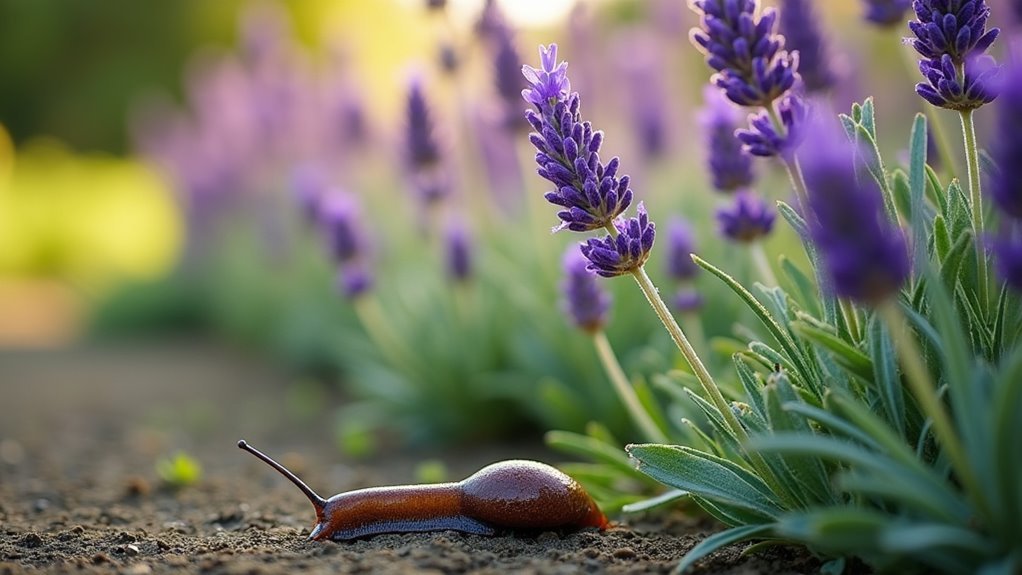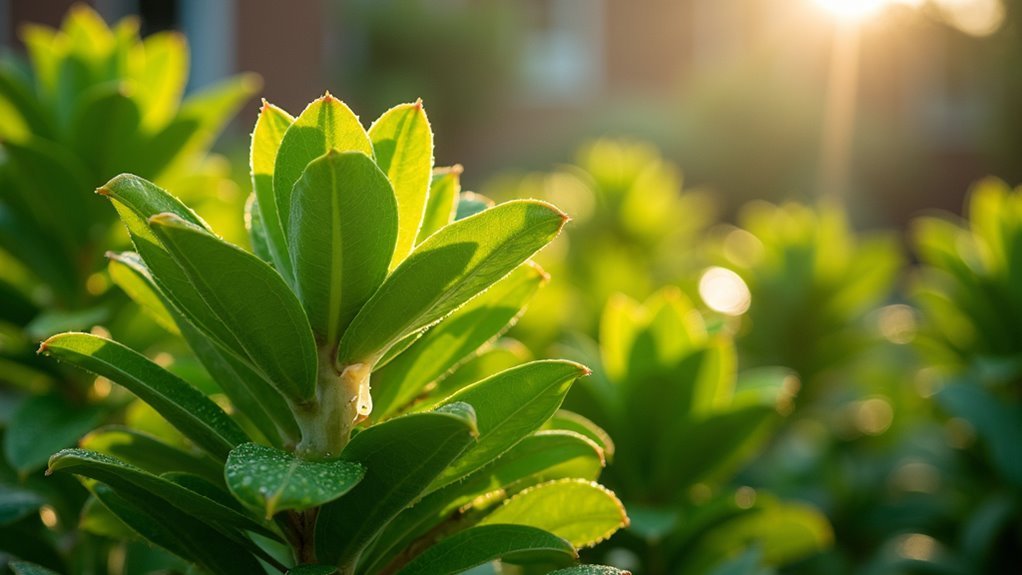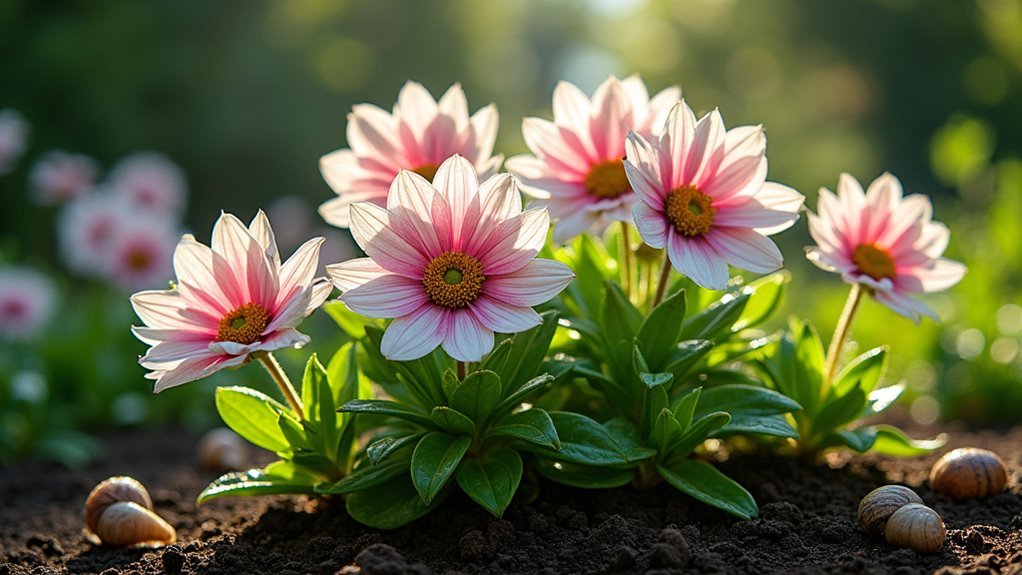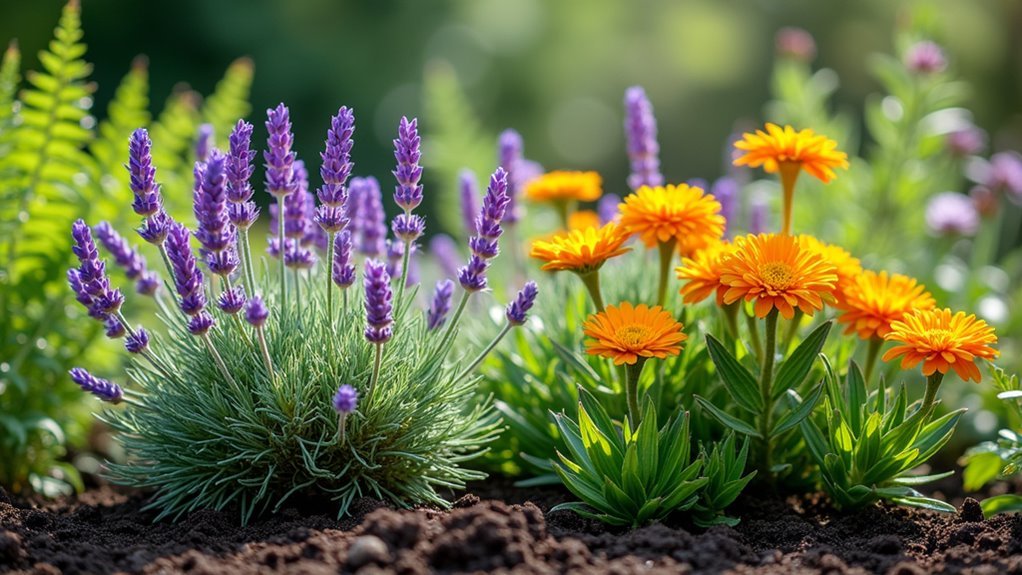You can protect your garden from slug damage by choosing plants with natural defenses like aromatic oils, toxic compounds, or fuzzy textures. Lavender’s oily foliage repels slugs while attracting pollinators, and foxglove’s toxic leaves create an effective barrier. Euphorbia’s milky sap deters feeding, while cranesbill geraniums offer robust, hairy leaves slugs avoid. For shaded areas, consider astrantia or Japanese anemone with their textured foliage. These strategic plant choices will transform your slug-prone garden into a thriving, pest-resistant landscape.
Lavender: The Aromatic Deterrent

When slugs encounter lavender’s oily, aromatic foliage, they’ll quickly retreat to find more palatable options elsewhere in your garden. This Mediterranean herb stands among the most effective slug-proof plants, combining natural pest control with stunning visual appeal.
You’ll love how lavender’s fragrant foliage creates a protective barrier around vulnerable plants while attracting beneficial pollinators like bees and butterflies.
Plant lavender in sun-baked borders or containers where it’ll thrive with minimal care. Once established, it’s incredibly drought-tolerant, making maintenance effortless.
Lavender flourishes in sunny spots with minimal fuss, becoming beautifully drought-resistant once its roots are established.
The strong aroma doesn’t just repel slugs—it adds delightful fragrance to your outdoor space. With various cultivars available, you can choose different heights and flower colors to enhance your garden’s aesthetic while maintaining powerful slug-deterrent properties.
Foxglove: Toxic Beauty That Slugs Avoid
Few plants combine such striking beauty with natural slug resistance as effectively as foxglove. These stunning perennials feature toxic leaves containing digoxin, making them completely unpalatable to slugs. The hairy leaves provide an additional deterrent that slugs simply won’t cross.
Foxgloves adapt to various soil types and light conditions, producing magnificent flower spikes that enhance your garden’s visual appeal. As reliable slug resistant plants, they’re essential for effective slug control without chemicals.
| Cultivar | Height | Bloom Color |
|---|---|---|
| Sutton’s Apricot | 3-4 feet | Soft apricot |
| Pam’s Split | 4-5 feet | Split petals, varied |
| Excelsior Hybrid | 5-6 feet | Mixed colors |
| Alba | 3-4 feet | Pure white |
These biennial beauties self-seed readily, ensuring continuous protection against slug damage while maintaining stunning garden displays year after year.
Euphorbia: Milky Sap Protection

Another powerhouse in the slug-resistant arsenal, Euphorbia’s secret weapon lies in its milky latex sap that creates an impenetrable barrier against these garden pests.
This milky sap irritates human skin and proves equally unpalatable to slugs, effectively deterring them from feeding on your plants.
You’ll appreciate Euphorbia’s incredible diversity, ranging from annuals and perennials to shrubs and succulents, ensuring options for every garden style.
These slug-repelling champions thrive in sunny locations and become drought-tolerant once established, making them exceptionally low-maintenance choices.
The colorful bracts and small flowers provide stunning visual appeal while maintaining their protective qualities.
Consider popular varieties like ‘Ascot Rainbow’ and ‘Fireglow’ for gardens that combine aesthetic beauty with reliable slug resistance.
Cranesbill Geraniums: Hardy and Reliable Defense
You’ll find cranesbill geraniums offer stunning, long-lasting blooms that keep your garden colorful throughout the growing season.
These hardy plants work beautifully in borders, rock gardens, woodland settings, and as ground cover, adapting to both sunny and partially shaded locations.
Their visual appeal makes them an excellent choice when you want slug protection without sacrificing your garden’s aesthetic quality.
Long-Flowering Visual Appeal
When you’re seeking plants that deliver both stunning visual impact and natural slug resistance, cranesbill geraniums stand out as exceptional performers in the garden.
These hardy geraniums showcase their long-flowering nature throughout the growing season, providing consistent blooms that maintain your garden’s beauty from spring through fall.
You’ll appreciate how their robust, hairy leaves create an effective barrier that slug naturally avoid, while simultaneously forming dense, attractive foliage that serves as a perfect backdrop for companion plants.
With numerous cultivars available, you can choose from vibrant colors and diverse flower shapes to enhance your garden design.
Their adaptability allows them to flourish in both sunny borders and partial shade locations.
Various Garden Situations
Beyond their aesthetic contributions, cranesbill geraniums excel in diverse garden settings where other plants might struggle with slug pressure.
Whether you’re dealing with sunny borders or shaded woodland areas, these slug-proof plants demonstrate remarkable versatility. Their tough foliage withstands various environmental conditions while maintaining effective slug deterrence.
You’ll appreciate how these hardy perennials create adaptable garden situations, thriving where challenging microclimates exist.
Their reliable growth guarantees consistent performance across different soil types and moisture levels. As they establish, cranesbill geraniums form dense ground cover that naturally suppresses weeds while creating protective barriers against slugs.
From formal garden beds to naturalized areas, you can count on their robust nature to outgrow early damage and flourish throughout the growing season.
Astrantia: Shade-Loving Slug Fighter

You’ll find Astrantia flourishing in those challenging shaded spots where many plants struggle, particularly under tree canopies where sunlight barely penetrates.
This perennial’s unique pincushion-like flowers don’t just resist slug damage—they actively attract beneficial pollinators like bees throughout the summer months.
You’re getting dual benefits with this shade-loving performer: effective pest deterrence and enhanced pollinator activity in your garden’s darker corners.
Thrives Under Tree Canopies
Although many gardeners struggle to find plants that thrive in the challenging conditions under tree canopies, Astrantia offers an elegant solution that combines shade tolerance with natural slug resistance.
This slug-proof perennial excels in the moist soil conditions typically found beneath trees, where many other plants fail to establish. You’ll find that Astrantia’s large lobed leaves remain untouched by slugs, even in these naturally humid shaded areas where pests usually proliferate.
The plant’s preference for well-watered conditions makes it perfectly suited for spots under tree canopies that retain moisture.
Popular cultivars like ‘Roma’ and ‘Moulin Rouge’ demonstrate exceptional slug resistance while adding stunning visual appeal to these often-neglected garden spaces, creating beautiful displays where other plants struggle.
Attracts Beneficial Garden Pollinators
While Astrantia defends your garden against slugs, its delicate pincushion flowers work double-duty by attracting essential pollinators throughout the growing season. This makes it one of the most valuable slug-proof plants you can grow in shaded areas.
From early to late summer, Astrantia’s distinctive blooms provide continuous nectar sources for bees and other beneficial insects.
What slugs hate about this perennial – its large, textured leaves – pollinators absolutely love about its flowers.
The plant’s ability to thrive in moist shaded conditions where many flowering plants struggle makes it particularly important for supporting diverse pollinator species.
Hellebores: Winter-Blooming Resistance
When winter’s chill settles over most gardens, hellebores burst into bloom with their distinctive saucer-shaped flowers, earning them the nickname “Lenten roses.”
These remarkable perennials don’t just provide much-needed color during the dormant season—their thick, leathery leaves create a natural barrier that slugs find unappetizing.
You’ll find hellebores particularly valuable in slug-prone areas where other plants struggle.
Varieties like Helleborus x hybridus thrive in shaded, moist conditions under trees—exactly where slugs typically flourish. Their resilience extends to various soil types, making them adaptable to diverse garden settings.
Beyond their winter-blooming beauty, these hardy plants attract beneficial pollinators when few other flowers are available, supporting your garden’s ecosystem year-round.
Ajuga Reptans: Ground Cover Protection
Ground-level protection becomes equally important when creating slug-resistant landscapes, and Ajuga reptans delivers exactly that with its dense, carpet-like growth.
You’ll find this bugleweed’s robust dark green foliage stays evergreen year-round while remaining completely unappealing to slugs. The plant’s versatility shines as it thrives in both sunny borders and shaded areas, making it perfect protective ground cover throughout your garden.
Once established, Ajuga reptans spreads readily, forming thick mats that deter slug activity around more vulnerable plants nearby.
You’ll enjoy striking dark blue flower spikes from late spring to mid-summer that attract beneficial pollinators.
This slug-resistant champion’s available from suppliers like Crocus, Suttons, and Thompson & Morgan, offering both beauty and effective slug protection.
Japanese Anemone: Late Season Slug Deterrent
You’ll love Japanese Anemones for their rough, textured leaves that slugs simply won’t touch.
These hardy perennials deliver stunning blooms from late summer through autumn, filling color gaps when most other plants have faded.
Their natural slug resistance combined with extended flowering makes them perfect for maintaining vibrant garden displays well into fall.
Rough Textured Leaves
Although most gardeners struggle with slug damage throughout the growing season, Japanese Anemones offer a brilliant solution with their naturally rough-textured leaves that these garden pests simply won’t touch.
The texture creates an uncomfortable surface that slugs actively avoid, making these slug-proof plants an effective natural barrier in your garden design.
You’ll find that rough leaves serve as an excellent first line of defense in your pest management strategy. When you plant Japanese Anemones strategically throughout your beds, they create slug-repellent zones that protect more vulnerable plants nearby.
This textural defense mechanism works consistently without requiring any chemical interventions, giving you a sustainable approach to controlling these destructive pests while maintaining beautiful garden aesthetics.
Late Summer Blooms
When most gardens begin to fade in late summer, Japanese Anemones burst into spectacular bloom, delivering waves of elegant daisy-like flowers that’ll carry your garden’s beauty straight through autumn.
These slug-resistant champions thrive when other plants struggle, creating stunning displays just as your garden needs them most.
You’ll love how these tough plants handle various soil conditions while their rough-textured leaves naturally repel slugs. Their vibrant flowers provide essential color during those shifting months between summer’s peak and winter’s approach.
Japanese Anemones effectively create protective zones around more vulnerable plants, making them strategic allies in your slug-fighting arsenal.
Whether you’re planting in borders or containers, these resilient perennials deliver both aesthetic appeal and practical pest control when you need it most.
Alchemilla Mollis: Textured Foliage Defense
With its distinctively furry, apple-green leaves, Alchemilla mollis creates a natural barrier that slugs find unappealing to traverse or consume. This slug-resistant perennial’s textured foliage acts as an effective deterrent, protecting both itself and neighboring plants from damage.
You’ll appreciate how Alchemilla mollis spreads into generous clumps, forming dense ground cover that blocks slugs’ access to vulnerable specimens.
The plant’s lime-green flower clusters emerge in early to mid-summer, adding visual appeal while maintaining its protective qualities. Its self-seeding nature means you’ll enjoy continuous coverage without extensive maintenance.
This hardy perennial thrives in various conditions, from full sun to shade, making it adaptable to different garden areas where slug protection is needed most.
Aquilegia: Cottage Garden Slug Resistance
Aquilegia brings the charm of traditional cottage gardens while offering reliable slug resistance that complements your existing protective plantings.
You’ll find varieties like Aquilegia vulgaris var. stellata Yellow Star particularly effective, as slugs naturally avoid their foliage despite its delicate appearance. This cottage garden favorite self-seeds readily, creating sustainable displays that require minimal intervention.
You can plant Aquilegia in partial shade or under trees, where reduced light helps minimize slug damage while the plants continue thriving. Their shade tolerance makes them versatile for various garden situations.
Beyond being slug-resistant, these plants attract beneficial pollinators, enhancing your garden’s biodiversity.
You’ll find quality plants available from reputable suppliers like Crocus, Sarah Raven, and Thompson & Morgan for reliable cottage garden performance.
Frequently Asked Questions
What Plants Do Slugs Hate Most?
Slugs hate toxic plants like foxgloves and euphorbia most. You’ll also repel them with hairy-textured plants like pulmonaria, strong-smelling herbs like lavender, and colorful varieties like photinia that signal danger.
Is There a Plant That Keeps Slugs Away?
You’ll find lavender works exceptionally well at keeping slugs away from your garden. Its strong scent naturally repels these pests, while you’ll also enjoy its beautiful purple flowers and pleasant fragrance throughout the growing season.
How Do I Permanently Get Rid of Slugs in My Garden?
You can’t permanently eliminate slugs, but you’ll greatly reduce them by combining copper barriers, removing garden debris, planting slug-resistant varieties, encouraging natural predators, and using sharp mulches like diatomaceous earth consistently.
What Is the Most Effective Slug Repellent?
You’ll find toxic plants like foxgloves and euphorbia work best as slug repellents. They contain compounds slugs find harmful or unpalatable, making them highly effective natural deterrents for your garden.
In Summary
You’ll find these slug-resistant plants transform your garden into a fortress against these persistent pests. You’re not just choosing beautiful blooms and foliage—you’re selecting nature’s own defense system. Plant these varieties strategically throughout your beds, and you’ll notice fewer nibbled leaves and damaged flowers. Don’t let slugs dictate your garden choices anymore. With these proven performers, you’ll enjoy stunning displays while keeping those slimy invaders at bay.





Leave a Reply